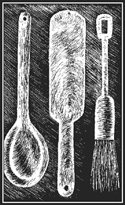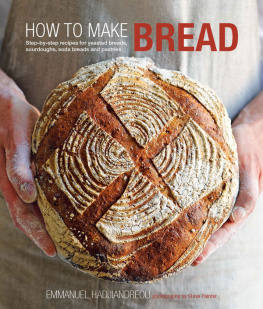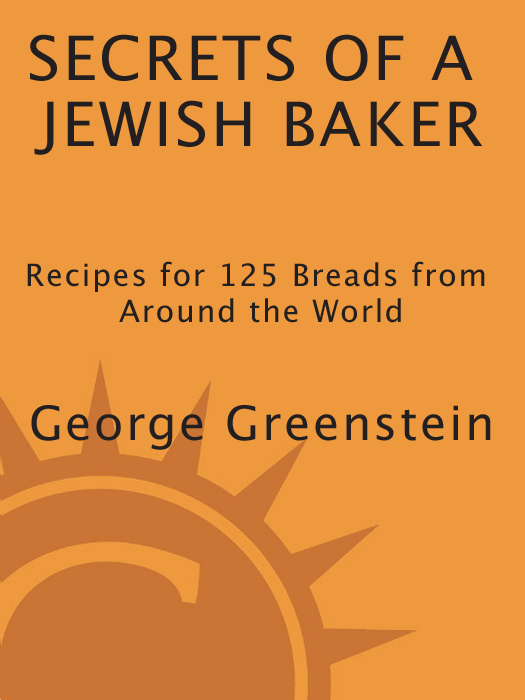Acknowledgments
I wish to thank all of the folks at Crossing Press, publishers of the original version of this work, especially Elaine Goldman Gill and Dennis Hayes, for understanding and helping to preserve the contributions of the old time bakers who plied their craft worldwide. Special thanks to Marcia Pudalov who convinced me that I could write the book, Elaine Greenstein who supplied me with motivation whenever it was lacking. Julia Greenstein, who was so proud of me and promoted the book wherever she could. At Ten Speed Press, thanks to Aaron Wehner and Dennis Hayes whom I suspect were influential in bringing the book into the Ten Speed family. Thanks to my editor, Meghan Keeffe, whose stewardship kept me honest and on schedule who was steering me always forward; and to all the folks at Ten Speed who were involved in this project. Thanks to my friend, Arthur Schwartz, author, radio personality, and culinary instructor, who gave me as much or more constant support and exposure than any person. And Nach Waxman at Kitchen Arts and Letters in New York, my biggest fan, my mentor, my friendthank you, Nach.

Copyright 1993, 2007 by George Greenstein Front cover photos by Nathan Benn/CORBIS (top) and Leigh Beisch (bottom)
All rights reserved. Published in the United States by Ten Speed Press, an imprint of the Crown Publishing Group, a division of Random House, Inc., New York.
www.crownpublishing.com
www.tenspeed.com
Ten Speed Press and the Ten Speed Press colophon are registered trademarks of Random House, Inc.
Original published in different form in the United States by The Crossing Press, in 1993.
Library of Congress Cataloging-in-Publication Data Greenstein, George.
Secrets of a Jewish baker: recipes for 125 breads from around the world / George Greenstein.Rev.
p. cm.
1. Bread. I. Title.
TX769.G734 2007
641.815dc22 2006101194
eISBN: 978-0-307-83446-1
food styling by Dan Becker and prop styling by Emma Star Jensen
v3.1
For my wife, Adele,
with love
for her patience, assistance,
and perception
CONTENTS
CHAPTER ONE
Basic Materials
CHAPTER TWO
Bread Making A to Z
CHAPTER THREE
Basic Yeast Bread
CHAPTER FOUR
Corn and Potatoes: Seeds of the Americas
CHAPTER FIVE
Breads of All Nations
CHAPTER SIX
Sourdough Breads
CHAPTER SEVEN
Rolls
CHAPTER EIGHT
Biscuits and Muffins
CHAPTER NINE
Quick Breads
CHAPTER TEN
Twelve Menus: A Morning of Baking
 How to Make the Rye Bread Sing
How to Make the Rye Bread SingThere is something sensual about kneading dough. Touching and molding it is a true hands-on experience. Savor the yeasty aroma. Its exciting to start with flour and water and feel the mixture come to life with an almost magical quality, stimulated by the gentle pressure of your hands.
I have spent my life working with my hands in pursuit of the perfect loaf. What is the perfect bread? How does one know when it has been found? Who is qualified to judge?
One night, working alone while the others were asleep, I was standing in front of a huge oven. Behind me was a wire rack containing more than two hundred loaves, hot and just removed from the oven. All was still in the bakery that very first time when I heard the rye bread sing. I turned and stood listening, at first without comprehension, then a smile, recognizing the soundfor me, a melody!
Occasionally, when making bread, everything comes together in harmony. The dough is flawless and the surrounding conditions are ideal. When the rye bread is removed from the oven, the crust begins to crack in the cooler air and form a finely veined appearance like alligator skin. To the bakers ear, the almost imperceptible crackling, multiplied a hundredfold, is a song of praise for the perfect loaf.

CHAPTER ONE
Basic Materials
 I n all my years as a professional baker, one of the most satisfying tasks has always been bread baking. What a wonderful reward there is when freshly baked loaves are placed on the dinner table, still warm from the oven. One often sees a look of awe on peoples faces when theyre told that the bread before them is homemade.
I n all my years as a professional baker, one of the most satisfying tasks has always been bread baking. What a wonderful reward there is when freshly baked loaves are placed on the dinner table, still warm from the oven. One often sees a look of awe on peoples faces when theyre told that the bread before them is homemade.
It has been my experience that many excellent cooks and bakers are intimidated by the thought of making bread at home. Yet bread baking can be made simple to understand for both the novice and the experienced baker. Errors can be easily corrected so that beginners first attempts are successful, and with a little practice, professional results can be achieved.
This book is more than just another collection of recipes. It is all about getting professional results using simple and foolproof bread-baking methods, while utilizing modern, time-saving systems without the need for expensive equipment. Whether this is your first attempt at bread making or you are an old hand, this book can be used as a complete bread-baking manual that will produce results sure to delight.
Nutrition and a balanced diet are continually taking on more important roles in our lives. Baking your own bread allows you to take more control of your familys diet. You can use natural, salt-free, low-fat, and low-cholesterol ingredients to make breads that will enhance your familys meals. Fiber-rich grains are easily added to breads, and many breads can be produced without sweeteners. Most assuredly, baking bread is one way to improve your familys nutrition and add to the enjoyment of your daily meals. I must stress at this point that all of the recipes in this book adhere to one simple rule: All of the recipes must taste good. None of this Styrofoam and cardboard nonsense foisted upon the American palate.
In the ensuing pages I share with you many of my hard-won and dearly paid for professional secrets. My father was a European trained baker and we operated bakeries in Queens and in Long Island for a total of over 30 years. I worked in food service in the army from 1952 to 1954. We operated bakeries in Long Island until his demise, then I continued together with my wife, Adele, until 1991. In that time I attended professional baking classes given in New York City under the auspices of the Bakers Union, and developed my own apprenticeship program for on the job training of disadvantaged young people. The professional recipes that we accumulated over the years, fine-tuned by us both, or those that Dad or I developed, were the basis for the formulary I devised for the home baker. The old European bakers jealously guarded their recipes and methods. I remember an elderly hunchbacked giant of a man grudgingly permitting a novice to weigh out the ingredients for a recipe that was about to be mixed. When it came to the critical ingredients, such as leavening, salt, spices, or flavoring, the master baker always seemed to find an excuse to send the novice to the storeroom for supplies or to the sink for a clean utensil. While the young man was gone, the baker would furtively add the important ingredients so that the newcomer would not be able to memorize the complete recipe.








 I n all my years as a professional baker, one of the most satisfying tasks has always been bread baking. What a wonderful reward there is when freshly baked loaves are placed on the dinner table, still warm from the oven. One often sees a look of awe on peoples faces when theyre told that the bread before them is homemade.
I n all my years as a professional baker, one of the most satisfying tasks has always been bread baking. What a wonderful reward there is when freshly baked loaves are placed on the dinner table, still warm from the oven. One often sees a look of awe on peoples faces when theyre told that the bread before them is homemade.